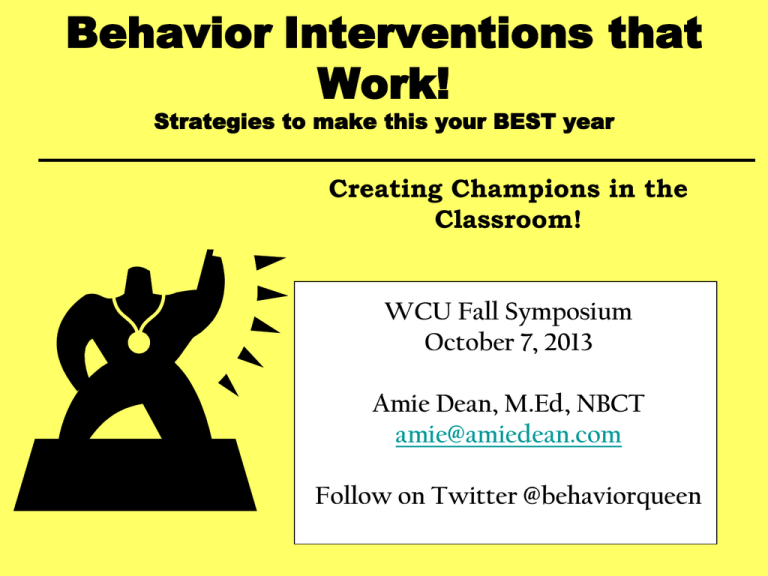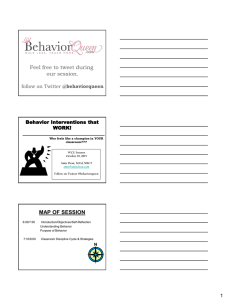Behavior Interventions that Work!
advertisement

Behavior Interventions that Work! Strategies to make this your BEST year Creating Champions in the Classroom! WCU Fall Symposium October 7, 2013 Amie Dean, M.Ed, NBCT amie@amiedean.com Follow on Twitter @behaviorqueen OBJECTIVES • • • • • • Identify YOUR strengths & needs Identify Foundations for Success Identify Mistakes to Avoid Experience Engaging Activities Identify YOUR communication pathway Recognize and Respect Differences What do YOU hope to gain from today? What do I want to accomplish in this seminar? Please answer these 3 questions. 1. What am I doing that is successful? 2. What am I doing that is NOT working? 3. What is my #1 GOAL for my students this year? Please share with a neighbor.... Questions to Consider …. 1. As children, where do we learn about “respect?” 2. How do you TEACH a “disrespectful” student to show you respect? 3. Where do we learn about how to deal with disappointment or failure? Playspent.org Courtesy Contract 1. (2-3) non-negotiables (what teacher needs) 2. (3) Replacement Behaviors (Bx) 3. In this we agree* __________ __________ __________ *Solicit from students what they need to feel respected Statistics About Behavior GOOD NEWS! 90% of students do what they are supposed to do 1-4 “Richards” 5….. 6+…. Purpose of Behavior Get Get Out Foundation 1 • PUBLIC RULES, PRIVATE DISCIPLINE • Students will accept discipline – Not disrespect. • What are some ways teachers exhibit disrespect? – 1. – 2. – 3. – 4. Discuss with Colleagues Foundation 2 • RELATIONSHIPS: Our influence lasts only as long as the relationship lasts. • “They don’t care what we know until they know we care.” • You can mean business without being mean. *Identify ways we can build/retain relationships with our students. Foundation 3 • What we Do is more important than how we Feel. – Ask yourself these TWO questions.... Foundation #4 Students need to know 3 things…... #1 Where they stand.. You have to teach, demonstrate, and reinforce procedures. (procedure manual) The best discipline is effective teaching. “Please refer to classroom rule # “ #2 The teacher WILL follow through If you tolerate it day after day … you teach it day after day. (p.34) # 3 The teacher is on their side! Discipline decisions need to be based on rules and goals not on feelings. -Ask yourself…What is my goal here? Teachers need to give themselves permission to be less than perfect - not less than professional. Preventative Discipline “Life is change. Growth is optional. Choose wisely.” Change is hard. Think about your management style. You can always change your practice without changing your passions. List at least 3 components of any successful behavior/classroom management plan. Classroom discipline cycle Level One Infractions in Classroom #1 Reminder 1 - Non-Verbal Warning • Post-it • Red Rule • Correction Card #2 -“The Look,” -Proximity -Touch Pad -Neon Clipboard -Tally -Hand Signal Reminder 2 - Verbal Warning – • Positively remind student what you want to see (“Thank you for getting to work.” ) • “If you choose to continue ________, you choose ________.” • Let them know the next infraction will result in consequence #3 Reminder 3 - Consequence Menu –Teacher Discretion • • • • Loss of privilege – flip the card – punch the card Last to Leave Silent lunch Apology Slip or Better Choices Sheet (in handout) More punitive • Time Out in another classroom & complete “Reflection Form” • Parent Contact – 3-5 day Behavior Contract (optional) #4 Consequence Office Referral – loss points Few Websites to Highlight • • • • Wholebrainteaching.com Classdojo.com Newmanagement.com Questgarden.com Pyramid to Promote Positive Behavior Let’s explore strategies for each component. There are 5 components. REFERRAL ----------------------- Tier Three 5-10% Students SMALL GROUP RESOLUTION --------------------------------------------- INTERVENTION/ REFLECTION Tier Two 10-20% Students --------------------------------------------------------------------------- POSITIVE INSTRUCTION Tier One 80-90% Students PREVENTION Pg. 12 in your handout Prevention • • • • • • • Post the rules (by the clock) Explain it then expect it. Proximity control (room arrangement). Be organized. Call To Attention Signal. (C2A) Positive tone – ASK A QUESTION Positive Group Contingency – Tally System Introducing the “Tally System” to your students! 1. Ask these 2 questions: – – What is your goal in this class? What do you think my goal is? 2. Solicit responses about goals, then ask what BEHAVIORS do we need to achieve those goals? 3. When they mention “talking, noise, or raise hands” – share your data about interruptions. 4. Ask what they feel is a “fair” number of disruptions. 5. Start with 5 in a 60 minute period. (Will vary by age) 6. Decide on a visual way to keep up each day. 7. Decide on a visual to keep up with long-term progress. 8. Generate list of rewards & vote on a class reward. Positive Instruction • Business-like approach • Success Strategies – Correction Cards – Promote Handraising – Less voice, more non-verbals • Voice is for Instruction and Affirmation • Positive Phrasing – Ask a question – be inviting Intervention/Reflection • Apology Form • Better Choices Sheet • Yes Card (Personal Data Sheet) Small Group Resolution • Conference (Time and privacy) • Contract (Party of 1st part…) • Understanding (What does this say?) Referral • Teacher needs help if … – Student hurts himself – Student hurts another – Student destroys property worth more than $5 Prevent with Non-verbal cues • • • • • Hand signals Music Bells/timers Post-it Notes Mystery Motivator - Whisper Club - Last Word Strategy -Behavior Bracelets - Last In Last Out Are you inviting students to learn? • Please/Thank you tally • Have student assistants (job for EVERYthing) Learning Carousel Examples of Choices/Options 1. Options for how students can demonstrate what they know – the seven P’s: Participation, Projects, Performances, Presentations, Portfolios, Products, Problem Posing & Analysis *Let students choose several to do for a unit of study. 2. Give 5 homework options a week. Students choose 3. 3. Give students one free homework pass each quarter. 4. Create 120 point tests in which students need to complete items totaling 100 points including some required items. 5. Allow students to develop their own project ideas as long as it meets criteria. 6. Give students option of creating one 3x5 study card to be used during a test. *By creating the card they have made a lot of effort to learn the content. Discuss with a partner… What are the 2 main reasons the disruptive student acts out? Why give choices??? Choices = _________ “ACTIVITY” Instructional Techniques to promote active engagement • Row Relays – worksheets passed back in a timed relay • “Trashketball” – Use balled up paper & trashcan. Students who raise hand to participate appropriately may take a 1, 2, or 3 point shot in the can. • Conversation Circles – inner/outer circle; • Learning Carousel – posters around the room, groups rotate and answer questions, complete problems, list information, discuss, or review – rotate w/music, • Jigsaw – Expert groups review material- Regroup so each new group has an expert for each section • Dry erase boards or SOLO plates – one per student • People Search – use grid with info in each box – students walk around and trade papers to get answers Multiple Intelligences “It’s not about how smart you are, it’s about how are you smart?” – Howard Gardner Agree or Disagree ? • Most teachers truly want to include all students, but we are often unsure how to do it. • Differentiated Instruction means no more whole-group instruction. • Our own learning style heavily persuades the way we teach. • Fair = all students completing the same learning activities. *Complete MI inventory. MI Carousel Great website!! http://www.igs.net/~cmorris/inventories_on_mi.html LET’S MOVE! • PEOPLE SEARCH • INVENTORY • SMART CARD – KAGANONLINE.COM Please fill out an evaluation. Thank you ALL for your time! Contact Information: amie@amiedean.com 404.578.0357 www.amiedean.com Twitter @behaviorqueen







